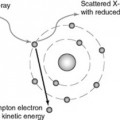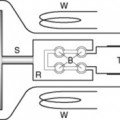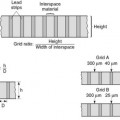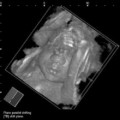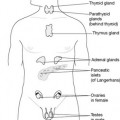Chapter 9 Production of X-rays
 The kinetic energy of projectile electrons transfers to target atoms. Approximately 99% of the energy converts into heat and only about 1% converts into X-rays.
The kinetic energy of projectile electrons transfers to target atoms. Approximately 99% of the energy converts into heat and only about 1% converts into X-rays. A bremsstrahlung interaction involves projectile electrons that emit radiation as they slow down when passing close to the nucleus of target atoms.
A bremsstrahlung interaction involves projectile electrons that emit radiation as they slow down when passing close to the nucleus of target atoms. A characteristic interaction involves the emission of radiation following a collision between projectile electrons and the orbital electrons of target atoms.
A characteristic interaction involves the emission of radiation following a collision between projectile electrons and the orbital electrons of target atoms. X-ray beam quality and quantity are affected by the target material, beam filtration, distance, and prime exposure factors (kVp, mA, and exposure time).
X-ray beam quality and quantity are affected by the target material, beam filtration, distance, and prime exposure factors (kVp, mA, and exposure time). The target material affects both the quality and quantity of the X-ray beam. Tungsten is the standard target material due to its high proton number.
The target material affects both the quality and quantity of the X-ray beam. Tungsten is the standard target material due to its high proton number. Peak kilovoltage (kVp) controls the quality of the beam. As kVp increases, X-rays are more penetrating and as kVp decreases, X-rays become less penetrating.
Peak kilovoltage (kVp) controls the quality of the beam. As kVp increases, X-rays are more penetrating and as kVp decreases, X-rays become less penetrating. kVp affects the quantity of X-rays produced. An increase in kVp rapidly increases the number of X-ray photons and a decrease in kVp rapidly decreases the number of X-rays. The amount of radiation produced is proportional to the square of the ratio of the kVp.
kVp affects the quantity of X-rays produced. An increase in kVp rapidly increases the number of X-ray photons and a decrease in kVp rapidly decreases the number of X-rays. The amount of radiation produced is proportional to the square of the ratio of the kVp. 15% rule: a 15% increase in kVp doubles radiographic density; a 15% decrease in kVp halves radiographic density.
15% rule: a 15% increase in kVp doubles radiographic density; a 15% decrease in kVp halves radiographic density. Reciprocity law: any combinations of mA and time that give the same mA s will result in the same quantity of X-ray photons.
Reciprocity law: any combinations of mA and time that give the same mA s will result in the same quantity of X-ray photons.TARGET INTERACTIONS
BREMSSTRAHLUNG INTERACTIONS
Bremsstrahlung in German means ‘to brake radiation’ or braking radiation. Bremsstrahlung target interaction occurs when projectile electrons pass by outer shell electrons of target atoms and interact with the force field of the nucleus of the atom. Because atomic nuclei are positively charged and electrons are negatively charged, there is a mutual attraction between them. The nuclear force field causes the entering electron to slow down (or brake) and change direction. The loss of kinetic energy that occurs when a projectile electron slows down is emitted as an X-ray photon. These X-ray photons are known as bremsstrahlung photons or brems radiation (Fig. 9.1). In the diagnostic range, approximately 85% of X-ray emissions are the result of bremsstrahlung interactions.











